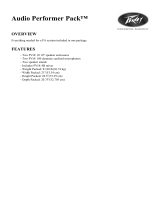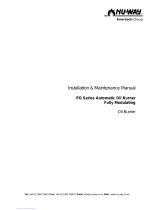
PV500-22A 08-98 4 Section 22A
PVI FIREPOWER
B40 OIL BURNER START-UP (con't)
After purging is complete, terminal 3 energizes
the oil valve and terminal 4 energizes the ignition
transformer. The flame is then established and
the VDC reading on the meter should read a
steady 14-18 VDC for photocell or 4-6 VDC for
UV amplifiers. Each different control will have the
required flame response signal stamped on it.
This is the minimum for it to properly operate. If
the burner fails to light during the initial period, it
is probably due to air in the line. The control will
lock out. Push the flame safeguard reset button
to restart burner and begin the purge cycle again.
Once the flame is established, set the oil
pressure (measured at the oil pump) at the
pressure shown on the tag attached to the
burner. Oil pressure should be adjusted while
firing on the second stage. Do not exceed the oil
supply pressure specified on the setup tag.
16. Two stage oil burners. Before turning the unit
on, make sure all valves in the oil supply and
return lines are on. Check the first stage air
damper setting against the setup tag attached to
the burner. The second stage air setting must be
adjusted while the burner is operating. Turn the
unit on using the rocker switch on the side of the
control cabinet. If the operating control switches
are closed, the burner blower should come on
and prepurge begin.
If nothing happens, check the control to be sure it
is not in the tripped position and reset it by
pushing the flame safeguard reset button. The
burner should prepurge for no longer than thirty
seconds.
After purging is complete, terminal 3 energizes
the oil valve and terminal 4 energizes the ignition
transformer. The flame is then established and
terminal 5 energizes the main oil valve after a
short delay. This will simultaneously supply oil to
the second stage oil nozzle and the damper
actuator, driving the damper open. The burner
can be temporarily locked in the first or second
stage by adjusting the low-fire hold switch. The
VDC reading on the meter should read a steady
14-18 VDC for photocell or 4-6 VDC for UV
amplifiers. Each different control will have the
required (minimum) flame response signal
stamped on it. If the burner fails to light during the
initial period, check for air in the line. The control
will lock out. Push flame safeguard reset button
to restart burner and begin purge cycle again.
Once the flame is established, set the oil pressure
(measured at the oil pump) at pressure shown on
the tag attached to the burner. Oil pressure should
be adjusted while firing on the second stage. Do
not exceed the oil supply pressure specified on
the setup tag.
17. Check flue gases with a flue analyzer and smoke
spot pump to make final settings of the air
damper.
a. Readings need to be taken from a hole in the
vent several inches from flue outlet
connection.
b. Insert draft gauge into the test opening in the
stack. Draft in stack should read -.02" to -.06"
W.C. Adjust draft regulator, if installed.
c. Insert analyzer in test opening and determine
O
2
content in percentage.
d. Gradually close air damper to decrease O
2
reading or open air damper to increase O
2
reading until optimum O
2
% (4-5%) is reached.
Refer to Figure 22-2 & 5, pages 7 & 8 for
damper adjustment details.
e. Once the O
2
reading is in the specified range,
check smoke content in the flue gas by
pumping ten times through a new smoke spot
sample paper. Smoke spot should not exceed
a #2. If the smoke spot exceeds a #2, it may
be necessary to increase the O
2
%.
f. Once combustion is set, take note of the gross
stack temperature; maximum gross stack is to
be 400°F, minimum net stack is to be 300°F.
(NOTE: net temperature is the total stack
temperature, less room temperature.) If an
excessively high gross stack temperature is
recorded, consult the factory.
g. Make sure air shutter is locked securely in
place.
18. On two-stage oil burners, the preceding analysis
must be done for the first and second stage.
19. Check each operating and limit control to be sure
they function properly by lowering and raising the
temperature setting on each of the controls,
causing the burner to cycle on and off.












